Understanding Language Structures: Sentences, Clauses, and Morphology
VerifiedAdded on 2019/09/24
|8
|869
|117
Report
AI Summary
The assignment content discusses language structures, specifically focusing on verb groups and sentence types. It provides examples of intransitive, auxiliary, passive, dynamic, modal, main, and static verbs, as well as sentences with different structures such as simple, compound, complex, and complex-compound sentences. The content also includes a discussion on the geographical origins and economic consequences of language structures, as well as references to various research papers on language processing and education.
Contribute Materials
Your contribution can guide someone’s learning journey. Share your
documents today.

Running Head: LANGUAGE STRUCTURES
LANGUAGE STRUCTURES
LANGUAGE STRUCTURES
Secure Best Marks with AI Grader
Need help grading? Try our AI Grader for instant feedback on your assignments.
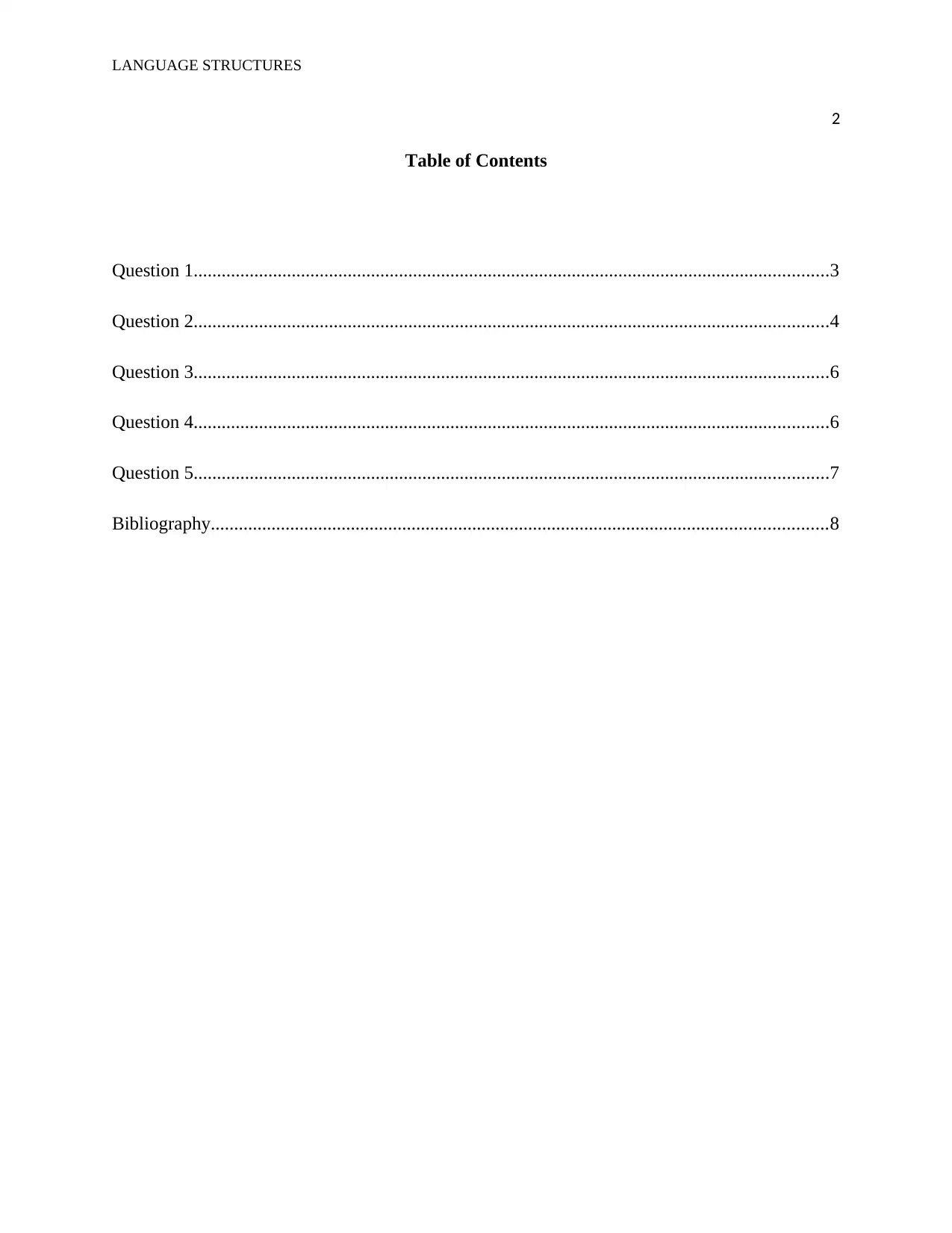
LANGUAGE STRUCTURES
2
Table of Contents
Question 1........................................................................................................................................3
Question 2........................................................................................................................................4
Question 3........................................................................................................................................6
Question 4........................................................................................................................................6
Question 5........................................................................................................................................7
Bibliography....................................................................................................................................8
2
Table of Contents
Question 1........................................................................................................................................3
Question 2........................................................................................................................................4
Question 3........................................................................................................................................6
Question 4........................................................................................................................................6
Question 5........................................................................................................................................7
Bibliography....................................................................................................................................8
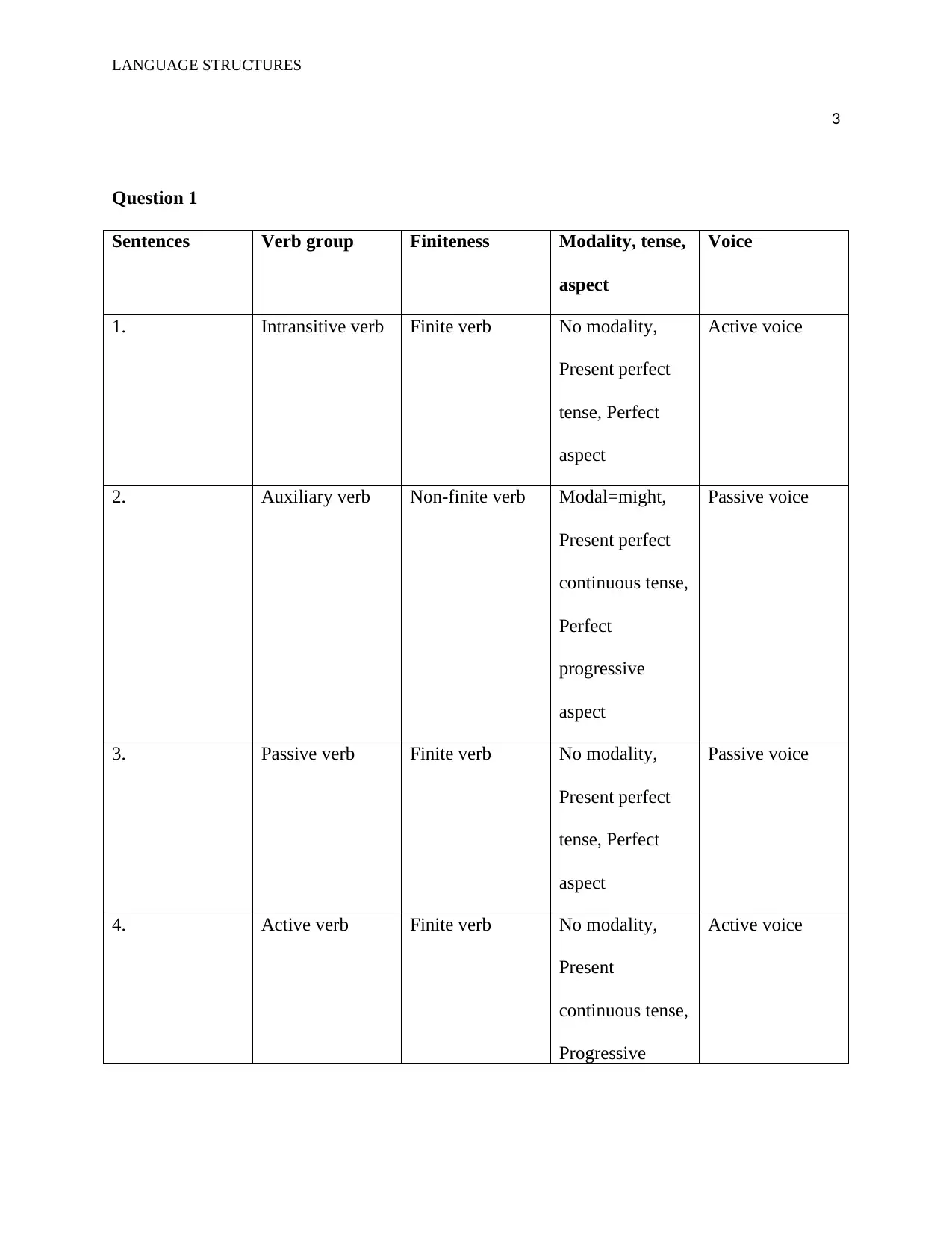
LANGUAGE STRUCTURES
3
Question 1
Sentences Verb group Finiteness Modality, tense,
aspect
Voice
1. Intransitive verb Finite verb No modality,
Present perfect
tense, Perfect
aspect
Active voice
2. Auxiliary verb Non-finite verb Modal=might,
Present perfect
continuous tense,
Perfect
progressive
aspect
Passive voice
3. Passive verb Finite verb No modality,
Present perfect
tense, Perfect
aspect
Passive voice
4. Active verb Finite verb No modality,
Present
continuous tense,
Progressive
Active voice
3
Question 1
Sentences Verb group Finiteness Modality, tense,
aspect
Voice
1. Intransitive verb Finite verb No modality,
Present perfect
tense, Perfect
aspect
Active voice
2. Auxiliary verb Non-finite verb Modal=might,
Present perfect
continuous tense,
Perfect
progressive
aspect
Passive voice
3. Passive verb Finite verb No modality,
Present perfect
tense, Perfect
aspect
Passive voice
4. Active verb Finite verb No modality,
Present
continuous tense,
Progressive
Active voice

LANGUAGE STRUCTURES
4
aspect
5. Dynamic verb Finite verb No modality,
Present perfect
continuous tense,
Perfect
progressive
aspect
Passive voice
6. Modal verb Finite verb Modal=can,
Simple present
tense, Simple
aspect
Passive voice
7. Main verb Non-finite verb Modal=will,
Simple future
tense, Simple
aspect
Active voice
8. Static verb Non-finite verb No modality,
Simple present,
Simple aspect
Active voice
Table 1: Verb groups
(Source: Created by Researcher)
4
aspect
5. Dynamic verb Finite verb No modality,
Present perfect
continuous tense,
Perfect
progressive
aspect
Passive voice
6. Modal verb Finite verb Modal=can,
Simple present
tense, Simple
aspect
Passive voice
7. Main verb Non-finite verb Modal=will,
Simple future
tense, Simple
aspect
Active voice
8. Static verb Non-finite verb No modality,
Simple present,
Simple aspect
Active voice
Table 1: Verb groups
(Source: Created by Researcher)
Secure Best Marks with AI Grader
Need help grading? Try our AI Grader for instant feedback on your assignments.
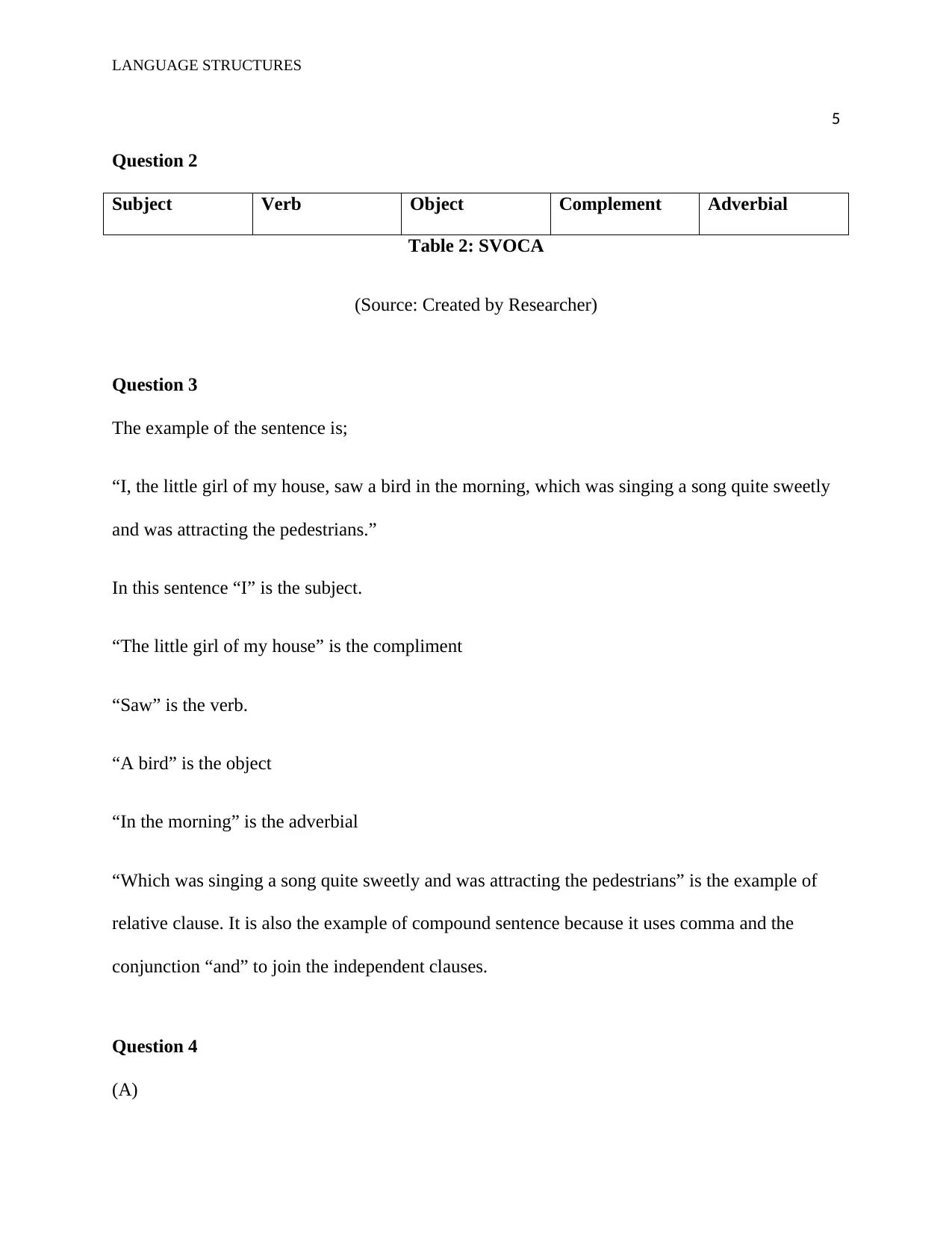
LANGUAGE STRUCTURES
5
Question 2
Subject Verb Object Complement Adverbial
Table 2: SVOCA
(Source: Created by Researcher)
Question 3
The example of the sentence is;
“I, the little girl of my house, saw a bird in the morning, which was singing a song quite sweetly
and was attracting the pedestrians.”
In this sentence “I” is the subject.
“The little girl of my house” is the compliment
“Saw” is the verb.
“A bird” is the object
“In the morning” is the adverbial
“Which was singing a song quite sweetly and was attracting the pedestrians” is the example of
relative clause. It is also the example of compound sentence because it uses comma and the
conjunction “and” to join the independent clauses.
Question 4
(A)
5
Question 2
Subject Verb Object Complement Adverbial
Table 2: SVOCA
(Source: Created by Researcher)
Question 3
The example of the sentence is;
“I, the little girl of my house, saw a bird in the morning, which was singing a song quite sweetly
and was attracting the pedestrians.”
In this sentence “I” is the subject.
“The little girl of my house” is the compliment
“Saw” is the verb.
“A bird” is the object
“In the morning” is the adverbial
“Which was singing a song quite sweetly and was attracting the pedestrians” is the example of
relative clause. It is also the example of compound sentence because it uses comma and the
conjunction “and” to join the independent clauses.
Question 4
(A)
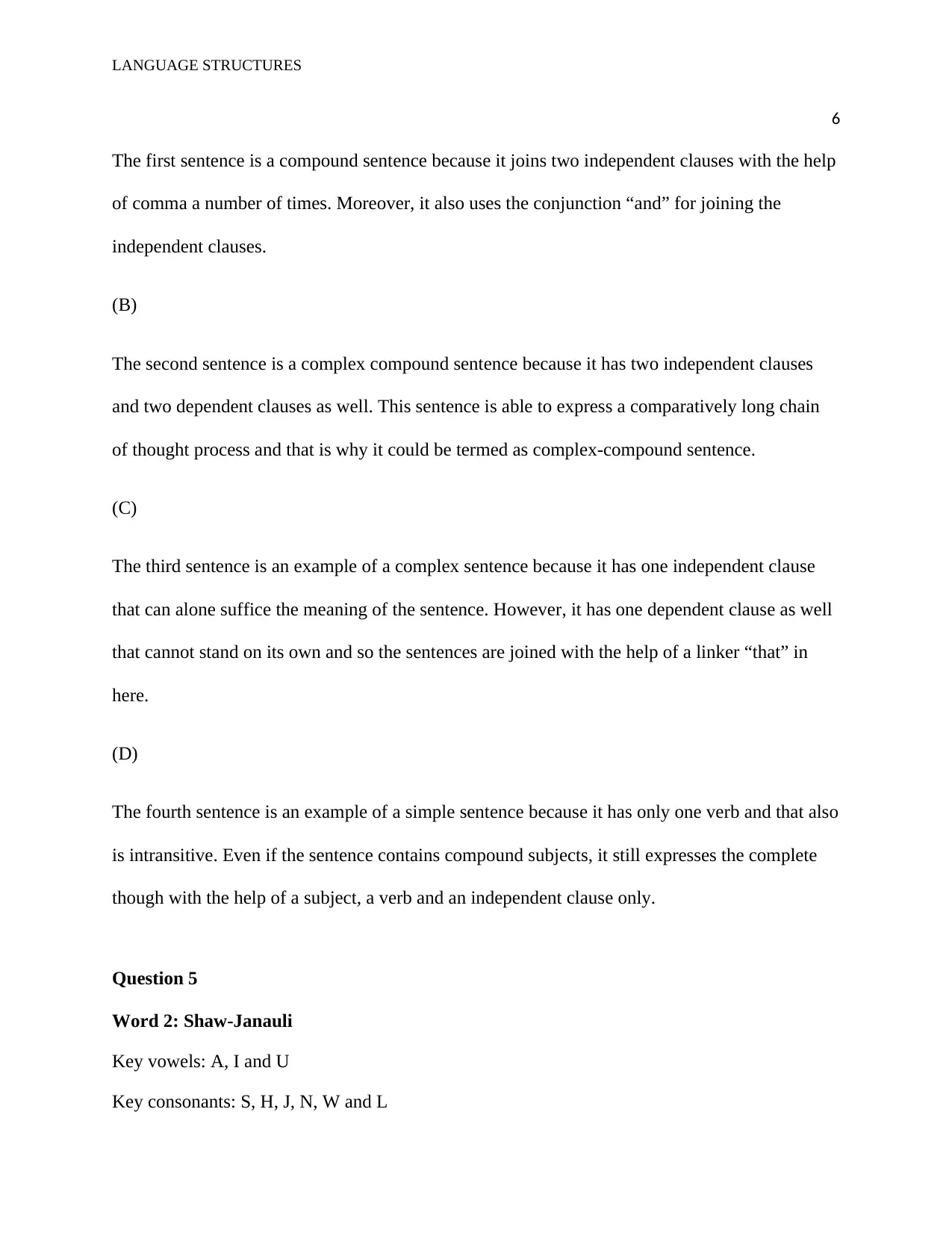
LANGUAGE STRUCTURES
6
The first sentence is a compound sentence because it joins two independent clauses with the help
of comma a number of times. Moreover, it also uses the conjunction “and” for joining the
independent clauses.
(B)
The second sentence is a complex compound sentence because it has two independent clauses
and two dependent clauses as well. This sentence is able to express a comparatively long chain
of thought process and that is why it could be termed as complex-compound sentence.
(C)
The third sentence is an example of a complex sentence because it has one independent clause
that can alone suffice the meaning of the sentence. However, it has one dependent clause as well
that cannot stand on its own and so the sentences are joined with the help of a linker “that” in
here.
(D)
The fourth sentence is an example of a simple sentence because it has only one verb and that also
is intransitive. Even if the sentence contains compound subjects, it still expresses the complete
though with the help of a subject, a verb and an independent clause only.
Question 5
Word 2: Shaw-Janauli
Key vowels: A, I and U
Key consonants: S, H, J, N, W and L
6
The first sentence is a compound sentence because it joins two independent clauses with the help
of comma a number of times. Moreover, it also uses the conjunction “and” for joining the
independent clauses.
(B)
The second sentence is a complex compound sentence because it has two independent clauses
and two dependent clauses as well. This sentence is able to express a comparatively long chain
of thought process and that is why it could be termed as complex-compound sentence.
(C)
The third sentence is an example of a complex sentence because it has one independent clause
that can alone suffice the meaning of the sentence. However, it has one dependent clause as well
that cannot stand on its own and so the sentences are joined with the help of a linker “that” in
here.
(D)
The fourth sentence is an example of a simple sentence because it has only one verb and that also
is intransitive. Even if the sentence contains compound subjects, it still expresses the complete
though with the help of a subject, a verb and an independent clause only.
Question 5
Word 2: Shaw-Janauli
Key vowels: A, I and U
Key consonants: S, H, J, N, W and L
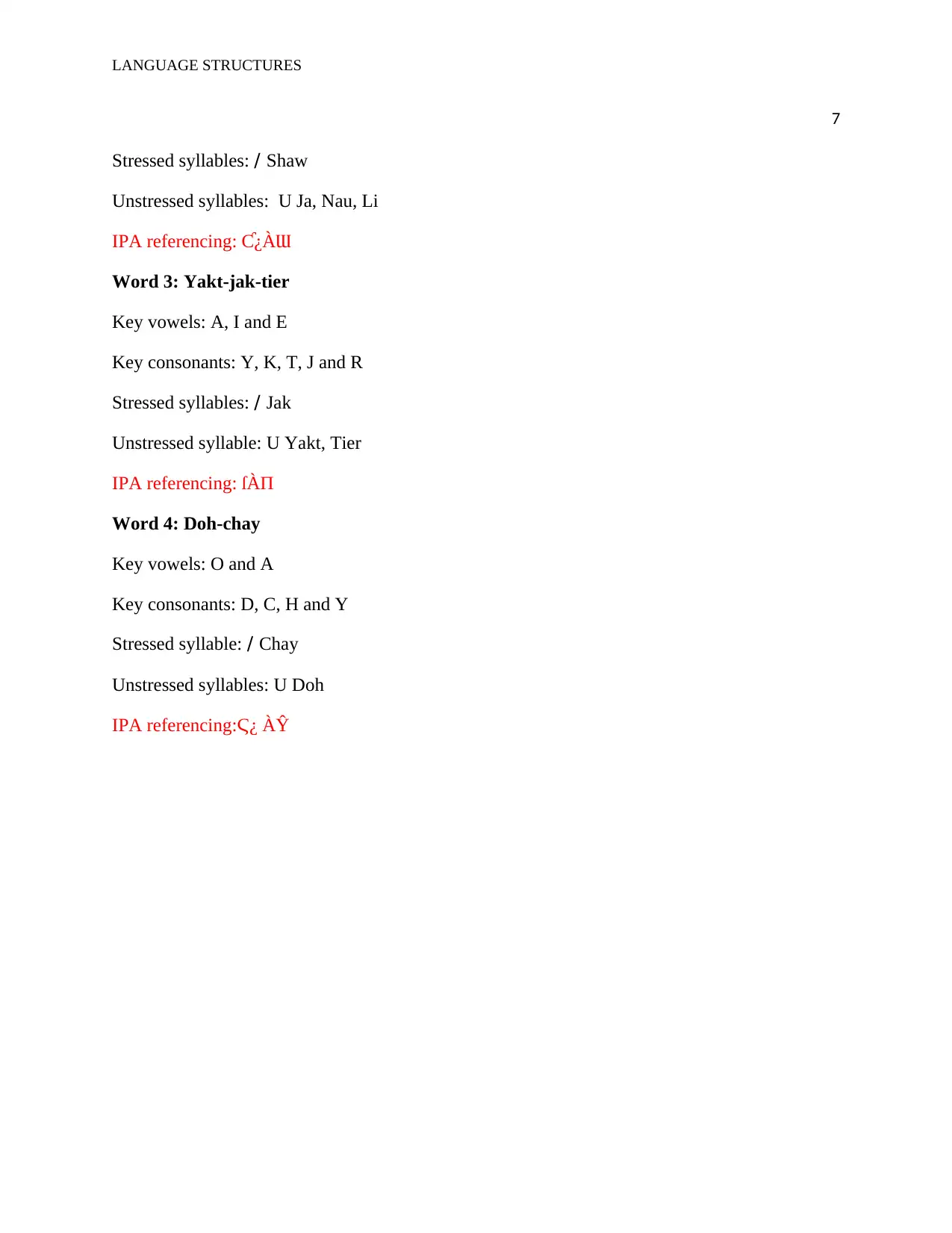
LANGUAGE STRUCTURES
7
Stressed syllables: / Shaw
Unstressed syllables: U Ja, Nau, Li
IPA referencing: Ƈ¿ÀƜ
Word 3: Yakt-jak-tier
Key vowels: A, I and E
Key consonants: Y, K, T, J and R
Stressed syllables: / Jak
Unstressed syllable: U Yakt, Tier
IPA referencing: ſÀΠ
Word 4: Doh-chay
Key vowels: O and A
Key consonants: D, C, H and Y
Stressed syllable: / Chay
Unstressed syllables: U Doh
IPA referencing:Ϛ¿ ÀŶ
7
Stressed syllables: / Shaw
Unstressed syllables: U Ja, Nau, Li
IPA referencing: Ƈ¿ÀƜ
Word 3: Yakt-jak-tier
Key vowels: A, I and E
Key consonants: Y, K, T, J and R
Stressed syllables: / Jak
Unstressed syllable: U Yakt, Tier
IPA referencing: ſÀΠ
Word 4: Doh-chay
Key vowels: O and A
Key consonants: D, C, H and Y
Stressed syllable: / Chay
Unstressed syllables: U Doh
IPA referencing:Ϛ¿ ÀŶ
Paraphrase This Document
Need a fresh take? Get an instant paraphrase of this document with our AI Paraphraser

LANGUAGE STRUCTURES
8
Bibliography
Galor, O., Özak, Ö., & Sarid, A. (2016). Geographical origins and economic consequences of
language structures. Retrieved on 25th August 2019 from:
https://papers.ssrn.com/sol3/papers.cfm?abstract_id=2877619
Mou, L., Li, G., Zhang, L., Wang, T., & Jin, Z. (2016, February). Convolutional neural networks
over tree structures for programming language processing. In Thirtieth AAAI Conference
on Artificial Intelligence. Retrieved on 25th August 2019 from:
https://www.aaai.org/ocs/index.php/AAAI/AAAI16/paper/viewPaper/11775
Park, Y., Xu, Y., Collins, P., Farkas, G., & Warschauer, M. (2018). Scaffolding learning of
language structures with visual‐syntactic text formatting. British Journal of Educational
Technology. Retrieved on 25th August 2019 from:
https://escholarship.org/content/qt6235t25b/qt6235t25b.pdf
Wang, W., Bi, B., Yan, M., Wu, C., Bao, Z., Peng, L., & Si, L. (2019). StructBERT:
Incorporating Language Structures into Pre-training for Deep Language Understanding.
arXiv preprint arXiv:1908.04577. Retrieved on 25th August 2019 from:
https://arxiv.org/pdf/1908.04577.pdf
8
Bibliography
Galor, O., Özak, Ö., & Sarid, A. (2016). Geographical origins and economic consequences of
language structures. Retrieved on 25th August 2019 from:
https://papers.ssrn.com/sol3/papers.cfm?abstract_id=2877619
Mou, L., Li, G., Zhang, L., Wang, T., & Jin, Z. (2016, February). Convolutional neural networks
over tree structures for programming language processing. In Thirtieth AAAI Conference
on Artificial Intelligence. Retrieved on 25th August 2019 from:
https://www.aaai.org/ocs/index.php/AAAI/AAAI16/paper/viewPaper/11775
Park, Y., Xu, Y., Collins, P., Farkas, G., & Warschauer, M. (2018). Scaffolding learning of
language structures with visual‐syntactic text formatting. British Journal of Educational
Technology. Retrieved on 25th August 2019 from:
https://escholarship.org/content/qt6235t25b/qt6235t25b.pdf
Wang, W., Bi, B., Yan, M., Wu, C., Bao, Z., Peng, L., & Si, L. (2019). StructBERT:
Incorporating Language Structures into Pre-training for Deep Language Understanding.
arXiv preprint arXiv:1908.04577. Retrieved on 25th August 2019 from:
https://arxiv.org/pdf/1908.04577.pdf
1 out of 8
Your All-in-One AI-Powered Toolkit for Academic Success.
+13062052269
info@desklib.com
Available 24*7 on WhatsApp / Email
![[object Object]](/_next/static/media/star-bottom.7253800d.svg)
Unlock your academic potential
© 2024 | Zucol Services PVT LTD | All rights reserved.